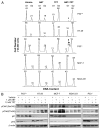Poly(ADP-ribose) polymerase inhibition enhances p53-dependent and -independent DNA damage responses induced by DNA damaging agent
- PMID: 22101337
- PMCID: PMC3272289
- DOI: 10.4161/cc.10.23.18170
Poly(ADP-ribose) polymerase inhibition enhances p53-dependent and -independent DNA damage responses induced by DNA damaging agent
Abstract
Targeting DNA repair with poly(ADP-ribose) polymerase (PARP) inhibitors has shown a broad range of anti-tumor activity in patients with advanced malignancies with and without BRCA deficiency. It remains unclear what role p53 plays in response to PARP inhibition in BRCA-proficient cancer cells treated with DNA damaging agents. Using gene expression microarray analysis, we find that DNA damage response (DDR) pathways elicited by veliparib (ABT-888), a PARP inhibitor, plus topotecan comprise the G1/S checkpoint, ATM, and p53 signaling pathways in p53-wildtype cancer cell lines and BRCA1, BRCA2 and ATR pathway in p53-mutant lines. In contrast, topotecan alone induces the G1/S checkpoint pathway in p53-wildtype lines and not in p53-mutant cells. These responses are coupled with G2/G1 checkpoint effectors p21(CDKN1A) upregulation, and Chk1 and Chk2 activation. The drug combination enhances G2 cell cycle arrest, apoptosis and a marked increase in cell death relative to topotecan alone in p53-wildtype and p53-mutant or -null cells. We also show that the checkpoint kinase inhibitor UCN-01 abolishes the G2 arrest induced by the veliparib and topotecan combination and further increases cell death in both p53-wildtype and -mutant cells. Collectively, PARP inhibition by veliparib enhances DDR and cell death in BRCA-proficient cancer cells in a p53-dependent and -independent fashion. Abrogating the cell-cycle arrest induced by PARP inhibition plus chemotherapeutics may be a strategy in the treatment of BRCA-proficient cancer.
Figures



Comment in
-
Chemotherapy-induced p53-dependent and -independent DNA damage responses are enhanced by poly(ADP-ribose) polymerase (PARP) inhibition in BRCA-proficient cancer cells.Cell Cycle. 2012 Feb 1;11(3):432-3. doi: 10.4161/cc.11.3.19167. Epub 2012 Feb 1. Cell Cycle. 2012. PMID: 22262190 No abstract available.
References
Publication types
MeSH terms
Substances
LinkOut - more resources
Full Text Sources
Research Materials
Miscellaneous
